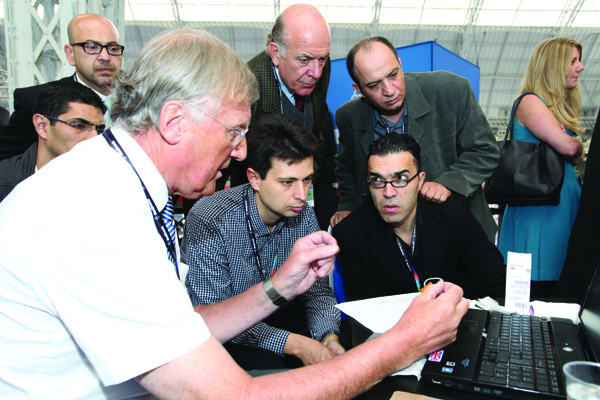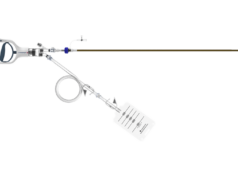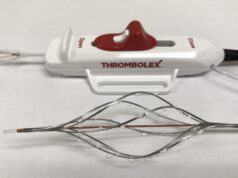
At the CX Office-based Vein Practice Course, delegates were granted the unique opportunity to view demonstrations and try office-based venous devices and procedures with the guidance of experienced tutors. The 2014 CX Office-based Practice Course saw record attendance with more than double the participants than in previous years. Over the two days, the Course welcomed 724 participants. The CX Office-based Vein Practice Course was led by Ian Franklin (Imperial College, London, UK).
According to Franklin, the Office-based Practice Course offered at the Charing Cross Symposium is the biggest of its kind and covers a wide range of techniques and procedures. In addition to that, Franklin maintained that this course is unique in that all attendees are acknowledged for their expertise.
“We do our visitors the compliment of acknowledging that they are all experts —everyone who comes is an expert—but they are experts in different aspects. So rather than making them sit through a rigid series of presentations on a list of things, some of which they will be familiar with, we set it up in a very flexible format so they can go to the training stations that they are interested in and when they get there, they can have one-on-one or small group interaction with world experts, and people really value that,” Franklin noted.
The Day 1 practice course had a strong emphasis on practical skills with simulators and equipment provided for attendees to learn ultrasound-guided cannulation, catheter positioning and tumescent anaesthesia. Other stations included: virtual ultrasound training with the Axiom simulator; deep vein thrombosis interventions including Trellis, Angiojet, suction thrombectomy and Ekos; leg ulcers and skin grafting under local anaesthetic; steam thermotherapy; ambulatory phlebectomy; deep vein thrombosis prophylaxis in the thrombophilic patient; microsclerotherapy for thread veins; Norseld laser treatment for thread veins; and marketing and social media for doctors.
The CX Office-based Vein Practice Course sees improvements and expansions year to year and Franklin explained that this year it featured a very large section on acute venous thrombosis and acute deep vein thrombosis and interventional techniques for treating deep vein thrombosis. Additionally, for the first time ever, the course featured four different lasers, three different radiofrequency catheters, endovenous glue, mechanochemical ablation and steam thermotherapy.
Charmaine Harrison (Guildford, UK) offered training on ultrasound-guided cannulation. She said that the opportunity to learn and practise is an invaluable one for doctors: “Learning these techniques requires a lot of practice and these simulators are very good because you cannot be putting needles into patients and missing the vein. A lot of people are having to learn new techniques very quickly because of shortages of infrastructure and finance so I think these courses are invaluable as a way of doctors having access to expert experience and opinion, and guidance and teaching that they might not get otherwise.”
Commenting on the CX Office-based Vein Practice Course, Lowell Kabnick (New Jersey, USA) called the expansion “brilliant”, adding that the CX course does not compare to others of its kind.
“I have travelled around and taught internationally and it is amazing that this course has morphed into the world’s best office-based course that I have seen, from the marketing of the course to the actual technical skills. What is great for me as a teacher is that I can go from station to station and I can pick up nuances that I have never seen other people do and bring that back to my practice. So not only is it good for people with basic knowledge, but it is also good for people with advanced skills, and to share that knowledge with my colleagues as well is amazing,” Kabnick stated.
In terms of the value of the CX Office-based Vein Practice Course to the attendees, Kabnick said that it is multi-purpose in that not only can the attendees gain hands-on experience, but they get the unique opportunity to have one-on-one discussions and training with the masters in the field.
From an industry perspective, Monte Madsen, vice president of Clinical Affairs at Sapheon, told CX Daily News that the CX Course is very valuable in terms of exposure because it showcases many of the available modalities and devices.
“This is a lot better than other courses because there is completeness to it. There is a wide selection of companies, as well as modalities and devices and they are all in one place. You don’t see that at other meetings,” Madsen stated.
Day 2 of the CX Office-based Veins Practice Course offered CHIVA; diagnostic ultrasound training; lymphoedema and compression therapy; foam sclerotherapy; microsclerotherapy for thread veins; ASVAL; pin stripping under local anaesthetic, Norseld laser for thread veins; surgical deep vein reconstruction; deep venous stenting; endovenous valves; pelvic vein treatments and pelvic congestion syndrome; case presentations; and website design and search engine optimisation for doctors.









